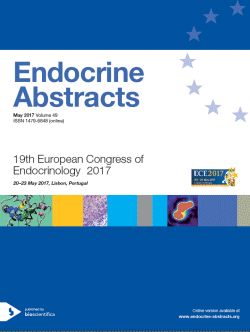
19th European Congress of Endocrinology
Lisbon,
Portugal
20 May 2017 - 23 May 2017
Guided Posters
Pituitary & endocrine Tumours
ea0049gp185 | Pituitary & endocrine Tumours | ECE2017
Localization of benign insulinomas using glucagon-like peptide-1 receptor (GLP1-R) SPECT/CT and PET/CT and MRI in a prospective clinical study
Antwi Kwadwo , Fani Melpomeni , Heye Tobias , Nicolas Guillaume , Merkle Elmar , Reubi Jean Claude , Gloor Beat , Wild Damian , Christ Emanuel
ea0049gp186 | Pituitary & endocrine Tumours | ECE2017
24 hour urinary 5-hydroxyindoleacetic acid (5-HIAA) doubling-time (DT) is associated with disease-specific mortality (DSM) and progression-free survival (PFS) in patients with neuroendocrine tumors (NETs)
Tirosh Amit , Nilubol Naris , Patel Dhaval , Kebebew Electron
ea0049gp187 | Pituitary & endocrine Tumours | ECE2017
Pasireotide alone or in combination with cabergoline effectively controls urinary free cortisol levels: results from a prospective study in patients with Cushing’s disease (CAPACITY)
Pivonello Rosario , Kadioglu Pritam , Bex Marie , Devia Deyanira Gonzalez , Boguszewski Cesar , Yavuz Dilek Gogas , Patino Heather , Campigotto Federico , Pedroncelli Alberto , Fleseriu Maria , Biller Beverly M K , Feelders Richard
ea0049gp188 | Pituitary & endocrine Tumours | ECE2017
Vertebral fractures are prevalent among patients with acromegaly in spite of normal bone mineral density reflecting overall duration of disease regardless of biochemical control or cure
Stojanovic Marko , Miljic Dragana , Pekic Sandra , Doknic Mirjana , Djurovic Marina Nikolic , Jemuovic Zvezdana , Popovic Vera , Petakov Milan
ea0049gp189 | Pituitary & endocrine Tumours | ECE2017
Evaluation of pituitary toxicity after radiotherapy for cerebral chondrosarcomas in adult patients
Laroche Suzanne , Feuvret Loic , Beauchet Alain , Dendale Remi , Chanson Philippe , Bruckert Eric , Jublanc Christel
ea0049gp190 | Pituitary & endocrine Tumours | ECE2017
Safety of long-term growth hormone (GH) treatment in adults with GH deficiency (GHD): an analysis from the NordiNet® International Outcome Study
Jorgensen Jens Otto , Popovic-Brkic Vera , Pournara Effie , Pedersen Birgitte , Chudecka Anita , Strasburger Christian
ea0049gp191 | Pituitary & endocrine Tumours | ECE2017
GH and IGF-1 levels at 12 weeks predict long-term responses to lanreotide Autogel in treatment-naïve acromegalic patients: post-hoc analyses from the PRIMARYS study
Caron Philippe , Petersenn Stephan , Houchard Aude , Sert Caroline , Bevan John S
ea0049gp192 | Pituitary & endocrine Tumours | ECE2017
Long-term treatment with pegvisomant (Somavert®): Observations from 2090 acromegaly patients followed in ACROSTUDY
vanderLely Aart Jan , Biller Beverly , Brue Thierry , Buchfelder Michael , Ghigo Ezio , Pan kaijie , Jonsson Peter , Lavenberg Joanne , Strasburger Christian J. , Webb Susan , Camacho-Hubner Cecilia , Hey-Hadavi Judith
ea0049gp193 | Pituitary & endocrine Tumours | ECE2017
Amenorrhea without vasomotor symptoms in women over 40: A sign of pathological hyperprolactinemia?
Ilovayskaya Irena , Dreval Alexader , Krivosheeva Yulia
ea0049gp194 | Pituitary & endocrine Tumours | ECE2017
Serotonin, ATRX and DAXX as differential diagnostic markers of neuroendocrine tumours (NETs) in the sellar region. An immunohistochemical study in a large series of pituitary adenomas and in a non-pituitary NET
Casar-Borota Olivera , Botling Johan , Granberg Dan , Wikstrom Johan , Ponten Fredrik , Trouillas Jacqueline
ea0049gp195 | Pituitary & endocrine Tumours | ECE2017
Long-term follow-up of a family with a large AIP gene deletion: variable phenotypes and challenges in the management
Marques Pedro , Dang Mary , Ogilvie Arla , Storr Helen , Powell Michael , Grieve Joan , Evason Jane , Kumar Ajith , Korbonits Marta
ea0049gp196 | Pituitary & endocrine Tumours | ECE2017
Diagnosis of acromegaly: Sex and BMI are the major determinants of growth hormone suppression during oral glucose tolerance test (OGTT)
Schilbach Katharina , Nicolay Shiva Sophia , Haenelt Michael , Lechner Andreas , Gar Christina , Schopohl Jochen , Stormann Sylvere , Schwaiger Rita , Bidlingmaier Martin



